Related Research Articles
Multiple hypotheses explain the possible connections between sleep and learning in humans. Research indicates that sleep does more than allow the brain to rest; it may also aid the consolidation of long-term memories.
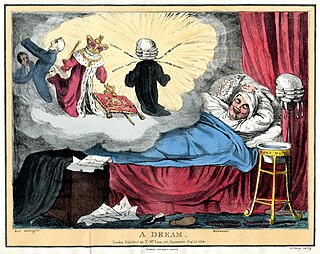
A dream is a succession of images, ideas, emotions, and sensations that usually occur involuntarily in the mind during certain stages of sleep. Humans spend about two hours dreaming per night, and each dream lasts around 5 to 20 minutes, although the dreamer may perceive the dream as being much longer than this.
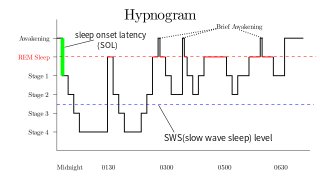
Rapid eye movement sleep is a unique phase of sleep in mammals and birds, characterized by random rapid movement of the eyes, accompanied by low muscle tone throughout the body, and the propensity of the sleeper to dream vividly.
Non-rapid eye movement sleep (NREM), also known as quiescent sleep, is, collectively, sleep stages 1–3, previously known as stages 1–4. Rapid eye movement sleep (REM) is not included. There are distinct electroencephalographic and other characteristics seen in each stage. Unlike REM sleep, there is usually little or no eye movement during these stages. Dreaming occurs during both sleep states, and muscles are not paralyzed as in REM sleep. People who do not go through the sleeping stages properly get stuck in NREM sleep, and because muscles are not paralyzed a person may be able to sleepwalk. According to studies, the mental activity that takes place during NREM sleep is believed to be thought-like, whereas REM sleep includes hallucinatory and bizarre content. NREM sleep is characteristic of dreamer-initiated friendliness, compared to REM sleep where it is more aggressive, implying that NREM is in charge of simulating friendly interactions. The mental activity that occurs in NREM and REM sleep is a result of two different mind generators, which also explains the difference in mental activity. In addition, there is a parasympathetic dominance during NREM. The reported differences between the REM and NREM activity are believed to arise from differences in the memory stages that occur during the two types of sleep.
Hypnagogia is the transitional state from wakefulness to sleep, also defined as the waning state of consciousness during the onset of sleep. Its opposite state is described as hypnopompia – the transitional state from sleep into wakefulness. Mental phenomena that may occur during this "threshold consciousness" phase include hypnagogic hallucinations, lucid dreaming, and sleep paralysis.

In the field of psychology, the subfield of oneirology is the scientific study of dreams. Current research seeks correlations between dreaming and current knowledge about the functions of the brain, as well as an understanding of how the brain works during dreaming as pertains to memory formation and mental disorders. The study of oneirology can be distinguished from dream interpretation in that the aim is to quantitatively study the process of dreams instead of analyzing the meaning behind them.
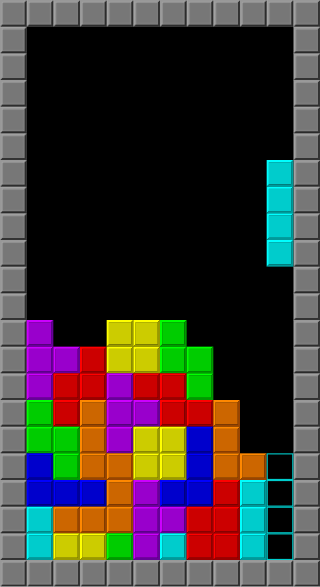
The Tetris effect occurs when people devote so much time and attention to an activity that it begins to pattern their thoughts, mental images, and dreams. It takes its name from the video game Tetris.

Alpine Racer 2 is a 3D alpine skiing arcade game released by Namco in 1996. It is the sequel to Alpine Racer. Unlike the original, two cabinets can be linked together so that players can race against each other.

Sleep medicine is a medical specialty or subspecialty devoted to the diagnosis and therapy of sleep disturbances and disorders. From the middle of the 20th century, research has provided increasing knowledge of, and answered many questions about, sleep–wake functioning. The rapidly evolving field has become a recognized medical subspecialty in some countries. Dental sleep medicine also qualifies for board certification in some countries. Properly organized, minimum 12-month, postgraduate training programs are still being defined in the United States. In some countries, the sleep researchers and the physicians who treat patients may be the same people.

John Allan Hobson was an American psychiatrist and dream researcher. He was known for his research on rapid eye movement sleep. He was Professor of Psychiatry, Emeritus, Harvard Medical School, and Professor, Department of Psychiatry, Beth Israel Deaconess Medical Center.
Sara C. Mednick is a sleep researcher at the University of California, Irvine. Her research focuses on the relationship between napping and performance. She is the author of several papers and a mass market book, Take a Nap! Change Your Life. She graduated with her PhD in psychology from Harvard University studying under Ken Nakayama and Robert Stickgold.
Mary A. Carskadon is one of the most prominent American researchers in sleep. She is a Professor in the Department of Psychiatry and Human Behavior at the Warren Alpert Medical School of Brown University. She is also the Director of the Sleep and Chronobiology Research Lab at E.P. Bradley Hospital. She is considered to be an expert on sleep and circadian rhythms during childhood, adolescence and young adulthood. She researches issues related to daytime sleepiness. She has also contributed important research on school start times as it relates to sleep patterns and sleepiness in adolescence. Every summer, Dr. Carskadon offers a prestigious summer internship for highly motivated students interested in sleep research at the Bradley Sleep Lab. These students, known as Dement Fellows, after William C. Dement, work in the sleep lab for the entirety of the summer and learn under Dr. Carskadon.
Robert W. McCarley, MD, (1937–2017) was Chair and Professor of Psychiatry at Harvard Medical School and the VA Boston Healthcare System. He is also Director of the Laboratory of Neuroscience located at the Brockton VA Medical Center and the McLean Hospital. McClarley was a prominent researcher in the field of sleep and dreaming as well as schizophrenia.
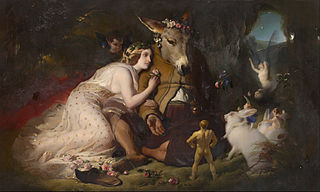
The majority of studies on sleep creativity have shown that sleep can facilitate insightful behavior and flexible reasoning, and there are several hypotheses about the creative function of dreams. On the other hand, a few recent studies have supported a theory of creative insomnia, in which creativity is significantly correlated with sleep disturbance.

The relationship between sleep and memory has been studied since at least the early 19th century. Memory, the cognitive process of storing and retrieving past experiences, learning and recognition, is a product of brain plasticity, the structural changes within synapses that create associations between stimuli. Stimuli are encoded within milliseconds; however, the long-term maintenance of memories can take additional minutes, days, or even years to fully consolidate and become a stable memory that is accessible. Therefore, the formation of a specific memory occurs rapidly, but the evolution of a memory is often an ongoing process.
Secondary consciousness is an individual's accessibility to their history and plans. The ability allows its possessors to go beyond the limits of the remembered present of primary consciousness. Primary consciousness can be defined as simple awareness that includes perception and emotion. As such, it is ascribed to most animals. By contrast, secondary consciousness depends on and includes such features as self-reflective awareness, abstract thinking, volition and metacognition. The term was coined by Gerald Edelman.
The activation-synthesis hypothesis, proposed by Harvard University psychiatrists John Allan Hobson and Robert McCarley, is a neurobiological theory of dreams first published in the American Journal of Psychiatry in December 1977. The differences in neuronal activity of the brainstem during waking and REM sleep were observed, and the hypothesis proposes that dreams result from brain activation during REM sleep. Since then, the hypothesis has undergone an evolution as technology and experimental equipment has become more precise. Currently, a three-dimensional model called AIM Model, described below, is used to determine the different states of the brain over the course of the day and night. The AIM Model introduces a new hypothesis that primary consciousness is an important building block on which secondary consciousness is constructed.

The neuroscience of sleep is the study of the neuroscientific and physiological basis of the nature of sleep and its functions. Traditionally, sleep has been studied as part of psychology and medicine. The study of sleep from a neuroscience perspective grew to prominence with advances in technology and the proliferation of neuroscience research from the second half of the twentieth century.
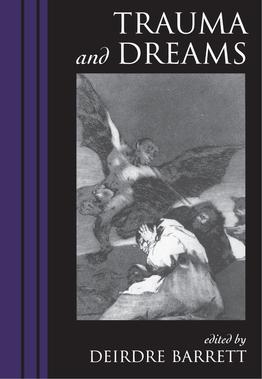
Trauma and Dreams is a 1996 book edited by Deirdre Barrett and published by Harvard University Press. Chapter authors are prominent psychologists and physicians including Oliver Sacks and Robert J. Lifton.
Jessica D. Payne is a psychologist and associate professor at the University of Notre Dame. Payne's research focuses on the impact of sleep and stress on human memory and psychological well-being. Payne won the Early Career Award from the Psychonomic Society in 2015. Previously, she received the Laird Cermak Award for early contribution to memory research by the International Neuropsychological Society in 2010. Payne has contributed her expertise on sleep to media outlets including New York Times, CNN, and Huffington Post.
References
- ↑ "PBS Scientific American Frontiers Bio". PBS .
- ↑ Konnikova, Maria (8 July 2015). "The Work We Do While We Sleep". The New Yorker. Retrieved 17 July 2015.
The Harvard sleep researcher Robert Stickgold has recalled his former collaborator J. Allan Hobson joking that the only known function of sleep is to cure sleepiness.
- ↑ Stickgold, R; Walker, MP (June 2007). "Sleep-dependent memory consolidation and reconsolidation". Sleep Medicine. 8 (4): 331–43. doi:10.1016/j.sleep.2007.03.011. PMC 2680680 . PMID 17470412.
- ↑ "Scientific American, Tetris Dreams".
- ↑ Zook, Kristal Brent. "The Boston Globe, Analyze This:What sparks our dreams, especially those wacky ones? One man is on the case". Boston.com.
- ↑ Stickgold, Bob (1981). The California coven project. New York: Ballantine Books. ISBN 0-345-28677-4. OCLC 7458814.